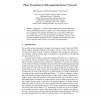Free Online Productivity Tools
i2Speak
i2Symbol
i2OCR
iTex2Img
iWeb2Print
iWeb2Shot
i2Type
iPdf2Split
iPdf2Merge
i2Bopomofo
i2Arabic
i2Style
i2Image
i2PDF
iLatex2Rtf
Sci2ools
ECAL
2003
Springer
2003
Springer
Phase Transitions in Self-Organising Sensor Networks
In this paper we consider a multi-cellular sensing and communication network, embedded in an ageless aerospace vehicle, that is expected to detect and react to impact location, intensity and damage over a wide range of impact energies. In particular, we investigate self-organisation of impact boundaries enclosing critically damaged areas, and measure their spatiotemporal robustness. The presented quantitative information-theoretic techniques clearly identify phase transitions, separating chaotic dynamics from ordered and robust patterns.
Ageless Aerospace Vehicle | ECAL 2003 | Impact Energies | Quantitative Information-theoretic Techniques |
| Added | 06 Jul 2010 |
| Updated | 06 Jul 2010 |
| Type | Conference |
| Year | 2003 |
| Where | ECAL |
| Authors | Mark Foreman, Mikhail Prokopenko, Peter Wang |
Comments (0)

